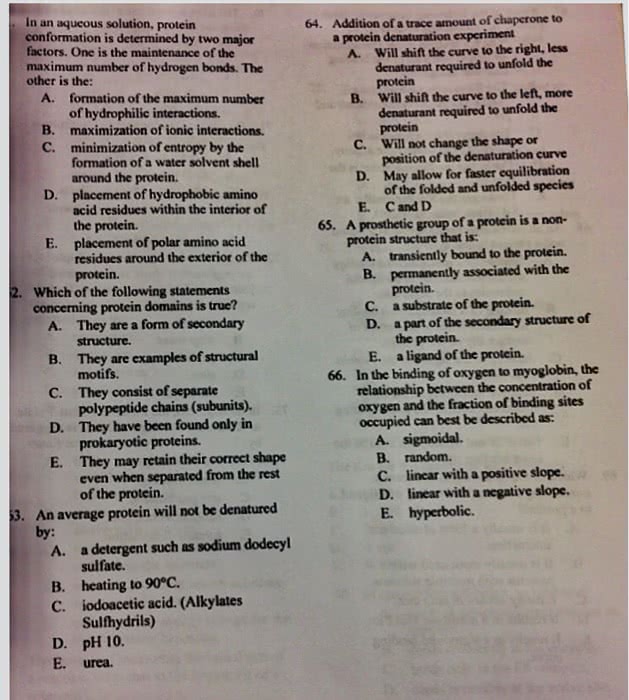BCEM 393 Lecture Notes - Lecture 7: Prolyl Isomerase, Radiography, Isomerase

Protein Structure
THE ANFINSEN EXPERIMENT
- Tried to answer the question: Is the 3D (primary, secondary, tertiary, and quaternary)
structure of a protein determined by the primary structure?
- Method: Anfinsen completely denatured (secondary and tertiary structures) and inactivated
ribonuclease with urea plus beta-ME
- Results were that the denatured reduced protein could be renatured and reactivated slowly
by slowly removing the agents
HOW DOES UREA DENATURE PROTEINS
- Urea is a small molecule with the ability to donate and accept hydrogen bonds
- It disrupts the hydrogen bonds within the proteins secondary and tertiary structures and
denatures the protein
- It also disrupts the structure of water (it is chaotropic1) and thus decreases the strength of
hydrophobic interactions
- Denaturation at the levels of secondary and tertiary structures would lead to the loss of the
quaternary structure of the protein
- Thermal activity (random movement of atoms/molecules) also helps to overcome the non
covalent interacts that hold the tertiary structure together
- Question: In Anfinsen’s experiment, beta-ME reduced and broke 4 disulfide linkages in
ribonuclease. What common oxidizing agent likely was present in the experiment and thus
reformed the disulfide linkages during the renaturation?
- Oxygen was present, which helped oxidize the disulfide linkage, and thus, broke the
linkage into two —SH groups
- Oxygen can only oxidize an —SH group is there is another —SH group near it
ITS AMINO ACID SEQUENCE DETERMINED 3D STRUCTURE OF A PROTEIN
- Interpretation of the Anfinsen Experiment
- The information needed to specify the 3D structure of ribonuclease is contained in its
amino acid sequence
- Primary sequence specifies structure
- Question: How does primary structure specify secondary, tertiary, and quaternary
structures?
- By ordering amino acids in a specific way, which would lead to certain patterns (helices,
turns, beta-sheets) in the structure of a protein
- Amino acid sequence also determines the types of interactions occurring between other
amino acids, and also which amino acids will interact with each other while giving the
maximum number of favourable interactions
- Sequence of amino acids also determined the maximum number of interactions
LEVINTHAL’S PARADOX
1 entropic disordering of the lipid bilayer by molecules dissolved in water
find more resources at oneclass.com
find more resources at oneclass.com
Document Summary
Method: anfinsen completely denatured (secondary and tertiary structures) and inactivated ribonuclease with urea plus beta-me. Results were that the denatured reduced protein could be renatured and reactivated slowly by slowly removing the agents. Urea is a small molecule with the ability to donate and accept hydrogen bonds. It disrupts the hydrogen bonds within the proteins secondary and tertiary structures and denatures the protein. It also disrupts the structure of water (it is chaotropic1) and thus decreases the strength of hydrophobic interactions. Denaturation at the levels of secondary and tertiary structures would lead to the loss of the quaternary structure of the protein. Thermal activity (random movement of atoms/molecules) also helps to overcome the non covalent interacts that hold the tertiary structure together. Question: in anfinsen"s experiment, beta-me reduced and broke 4 disulfide linkages in ribonuclease. Oxygen was present, which helped oxidize the disulfide linkage, and thus, broke the linkage into two sh groups.


